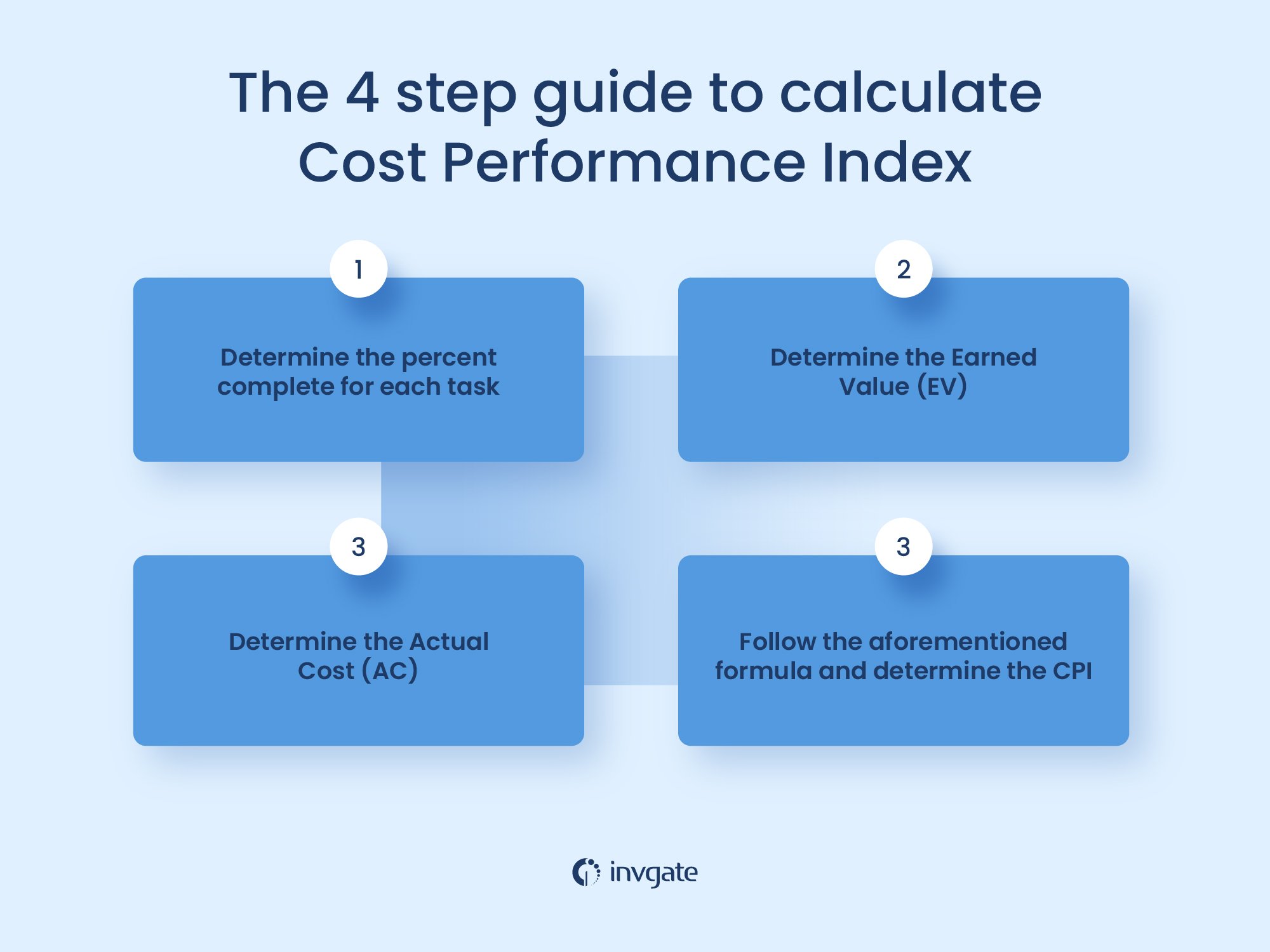In simple words, the Cost Performance Index (CPI) is an indicator of how a project is doing in terms of financial performance and efficiency through its lifetime. Though there are many indicators one can look at when assessing a project’s performance, CPI has become one of the most used in the industry.
CPI is a crucial part to determine if a project planning is successful. Project managers look at the Cost Performance Index to determine if a project is following the schedule or if corrective actions must be taken. Essentially, CPI (and also Cost Variance) indicates if the budget (also known as "planned value") is being used effectively and efficiently.
Narrowing it down, CPI can also be a method, a tool, or even a chart that is applied to figure out a project’s cost-effectiveness. From a mathematical standpoint, CPI reflects the amount of completed work for every unit of cost expended. This index is most often present in the Earned Value Management System (EVMS) since it lets project management professionals know about a project’s current state concerning the schedule.
Additionally, CPI can reflect if a particular task exceeds the budget or not. It works as a sort of snapshot in time, reflecting its cost-efficiency. Due to the fact that this index is always fluctuating as more work is done, projects can go over and below budget in an oscillating fashion.
To determine the overall project’s CPI, both the inherent Earned Value (EV) and Actual Cost (AC) need to be gauged task by task and summed up. Thus, if there have been changes to the EV and AC throughout a project’s lifetime, the CPI will suffer alterations. They key factor here is that the budgeted cost is never exceeded.
Cost Performance Index and its role in Project Management
Every project manager knows that project control processes such as estimating and managing a project’s budget are paramount to its success. Because budget restrictions are central, budget issues can be a complex hurdle to overcome with project status reporting and the ensuing discussion with stakeholders, participants and sponsors.
That’s why both Cost Performance Index and Schedule Performance Index (SPI) are key in project management, as they allow project management professionals to know how a project is performing budget-wise (similar to how Cost Variance does it). If there’s any deviation from the baseline, costs can easily go up, and that’s a definitive no-no.
Cost Performance Index Formula
In order to calculate Cost Performance Index, one has to divide the Earned Value by the Actual Cost. Thus, the CPI is determined by measuring the ratio of Earned Value to the Actual Cost.
If one wishes to asses the overall project’s CPI, the underlying Earned Value and Actual Cost must be gauged task by task and summed up, as it was stated before. It’s important that each task is assigned with both its data and the start and finish dates as they make up what’s called the cost baseline (also key for Earned Value Analysis).
The cost baseline works as a benchmark for the project management team to make comparisons. So, calculating CPI is part of the preparation phase of project scheduling and shall never be skipped, and neither should Schedule Performance Index for that matter.
To recap, the sum of each task performed is called Earned Value and its computed from the project’s budget.
Thus, the Cost Performance Index formula would look like this:
EV = Percent Complete x Budget of tasks
Actual Cost is the amount of paid for each individual task. The amount itself includes facilities, supplies, labor, and any other asset or item needed to finish the tasks. For example, if the actual cost of steel for a rigging is $2200 and the labor is $1300, AC would be $3500.
The 4 step guide to calculate CPI would be:
- Determine the percent complete for each task
- Determine the Earned Value (EV)
- Determine the Actual Cost (AC)
- Follow the aforementioned formula and determine the CPI
CPI above 1.00 would be considered favorable and cost-efficient. Conversely if CPI is below 1.00, it means that the company was losing money at the time the snapshot was taken.

Why would the Cost Performance Index fluctuate?
Fluctuations in CPI are a common occurrence, and depending on the timescale used to measure cost performance this could be more noticeable. The reason why CPI fluctuates could be attributed to a number of factors, including people, their equipment and even the weather.
It’s important to remember that 100% efficiency from workers, for example, is not something that stays that way all throughout a project’s lifespan. So, CPI fluctuates because the variables that affect a project’s CPI are constantly evolving, leading to peaks and troughs. This oscillations are known as a project’s operating range.
What is the Cost Performance Index operating range?
A CPI operating range is determined by how unpredictable factors influence a project. Ideally, you want your operating range to be stable. For instance, a project inside of a controlled environment such as an office will most likely have a narrower operating range than an off-shore construction. In addition, the Schedule Performance Index also operates in a similar fashion, for instance.
Since projects are team-based tasks and stakeholders and client will always want to be in the loop, these ranges should be agreed to by project management teams and stakeholders before work starts. These ranges are based on past project performance, expert insight and industry benchmarks.
If the operating range is agreed upon, the role of the project manager is to strive towards that CPI of 1.00. Course correction and slight adjustments to decrease downtime or redundant tasks are just some of the measures project managers can take to achieve a cost-efficient CPI and a narrow operating range.
Calculating Cost Performance Index with an example
Let's say that the company FromSoftware is assigned to project that needs to be completed in 2 years, and the budget (also known as budgeted cost) is 350,000 USD. A year has gone by and 100,000 USD has been used. After close inspection, 60% of the work has been completed. The Planned Value percentage varies according to a project’s level of completion at the time of analysis.
We could approach this situation as a math problem: first we calculate the CPI, and then deduce whether this project is under budget or over budget.
Actual Cost (AC) = 100,000 USD
Planned Value (PV) = 50% of 350,000 USD = 175,000 USD
Earned Value (EV) = 60% of 350,000 USD = 210,000 USD
Cost Performance Index (CPI) = EV/AC = 210,000 USD / 100,000 USD = 2.1
As you can see, the CPI for this project is 2.1
This is great news for FromSoftware, as it means that for every 1 USD spent, the company earns 2.1 USD. Since the CPI is higher than 1.00, this would mean that the project is under budget. Thus, the cost-efficiency parameters for this project are extremely positive.
Bottom line
The Cost Performance Index is an indicator of a project’s health and it’s one of the many tools (such Cost Variance, Schedule Performance Index and Complete Performance Index) within Earned Value Management Systems.
Its main goal is to determine if the work performed justifies the budget used to carry it out and deliver optimal results along the way.
Frequently asked questions
What is the Cost Performance Index?
The Cost Performance Index is a metric used to determine if tasks within a project use up more or less of the budget assigned to that project. If CPI is over 1.00 it means it’s under-budgeted, and if it’s below 1.00 it’s over-budgeted.
How is the Cost Performance Index calculated?
The formula is a project’s Earned Value divided by its Actual Cost. The resulting number represents a project’s CPI.
What is the Cost Performance Index’s operating range?
The operating range refers to the space delineated by a project’s peak of efficiency and it’s lowest point of efficiency. The narrower the operating range, the less oscillation there will be in CPI through a project’s lifespan.
What is a good Cost Performance Index?
In general, a CPI above 1.00 would be considered favorable and cost-efficient, whereas a CPI under 1.00 indicates that the organization is losing money, at least at the time when it was calculated.















